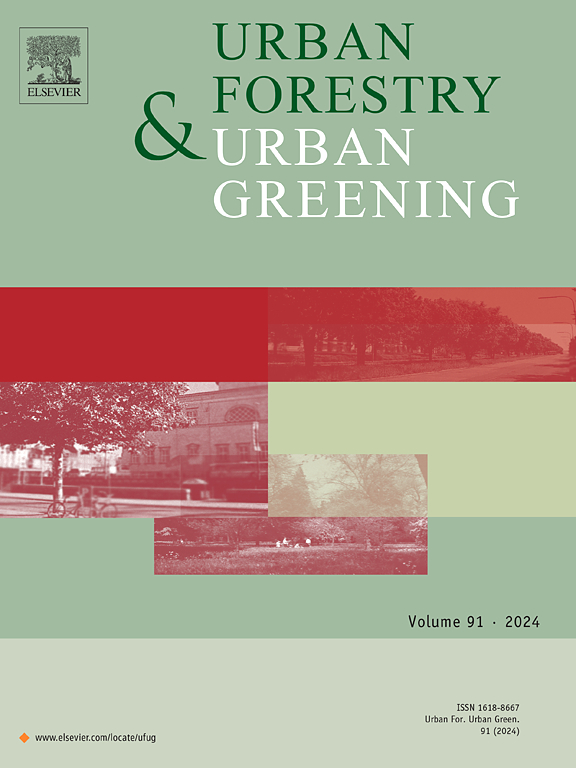Spatial and habitat determinants of small-mammal biodiversity in urban green areas: Lessons for nature-based solutions
IF 6
2区 环境科学与生态学
Q1 ENVIRONMENTAL STUDIES
引用次数: 0
Abstract
In an increasingly anthropogenic world, urban green areas are critical for human well-being because of the ecosystem services they offer. However, the management of these areas often prioritizes economic, architectural, and esthetic needs over ecological functionality, undermining the benefits they ought to provide. Actions to restore the functional ecological processes of urban green areas have thus become increasingly urgent. This study investigated the impact of urban green area characteristics on the community composition of an indicator animal group to inform Nature-Based Solutions (NBSs) for urban biodiversity and sustainability enhancement. We analyzed data on small mammal community composition from three Italian metropolitan cities (Milan, Florence, and Rome), focusing on the distribution pattern of synanthropic and non-synanthropic species. Small mammal surveys were carried out using hair tubes in sampled areas located along a gradient of green area size and fragmentation. Multiple Linear Mixed Models assessed the influence of spatial and habitat green area characteristics on species richness. Synanthropic species richness was positively associated with manicured urban parks, while non-synanthropic species richness was higher in woodland green areas characterized by high shrub cover. Through a Linear Mixed Model and NODF-based Nestedness analyses, we found that competitive exclusion and selective extinction/colonization processes did not significantly influence community composition. These insights emphasize the major influence of habitat composition in supporting functional communities of urban small mammals. To move toward resilient urban ecosystems, NBSs must primarily be implemented at a local scale by creating green patches with high habitat quality, and secondarily, they should be embedded in an interconnected and functional network at a city scale.
城市绿地中小型哺乳动物生物多样性的空间和生境决定因素:基于自然的解决方案的经验教训
在一个日益人为化的世界里,城市绿地对人类福祉至关重要,因为它们提供了生态系统服务。然而,这些地区的管理往往优先考虑经济、建筑和美学需求,而不是生态功能,从而破坏了它们应该提供的好处。因此,恢复城市绿地功能生态过程的行动变得越来越紧迫。本研究探讨了城市绿地特征对指示动物群落组成的影响,为城市生物多样性和可持续发展的自然解决方案提供依据。对意大利米兰、佛罗伦萨和罗马3个大都市的小型哺乳动物群落组成进行了分析,重点研究了共生性和非共生性物种的分布格局。小型哺乳动物调查采用毛管在采样区域沿绿色区域大小和破碎度梯度进行。多元线性混合模型评估了空间和生境绿化面积特征对物种丰富度的影响。物种丰富度与修剪后的城市公园呈正相关,而非物种丰富度在高灌木覆盖的林地绿地中更高。通过线性混合模型和基于nodf的巢性分析,我们发现竞争排斥和选择性灭绝/殖民化过程对群落组成没有显著影响。这些见解强调了生境构成对城市小型哺乳动物支持性功能群落的主要影响。为了向弹性城市生态系统发展,nbs首先必须在地方范围内实施,通过创造具有高栖息地质量的绿色斑块,其次,它们应该嵌入到城市规模的互联和功能网络中。
本文章由计算机程序翻译,如有差异,请以英文原文为准。
求助全文
约1分钟内获得全文
求助全文
来源期刊

Urban Forestry & Urban Greening
FORESTRY-
CiteScore
11.70
自引率
12.50%
发文量
289
审稿时长
70 days
期刊介绍:
Urban Forestry and Urban Greening is a refereed, international journal aimed at presenting high-quality research with urban and peri-urban woody and non-woody vegetation and its use, planning, design, establishment and management as its main topics. Urban Forestry and Urban Greening concentrates on all tree-dominated (as joint together in the urban forest) as well as other green resources in and around urban areas, such as woodlands, public and private urban parks and gardens, urban nature areas, street tree and square plantations, botanical gardens and cemeteries.
The journal welcomes basic and applied research papers, as well as review papers and short communications. Contributions should focus on one or more of the following aspects:
-Form and functions of urban forests and other vegetation, including aspects of urban ecology.
-Policy-making, planning and design related to urban forests and other vegetation.
-Selection and establishment of tree resources and other vegetation for urban environments.
-Management of urban forests and other vegetation.
Original contributions of a high academic standard are invited from a wide range of disciplines and fields, including forestry, biology, horticulture, arboriculture, landscape ecology, pathology, soil science, hydrology, landscape architecture, landscape planning, urban planning and design, economics, sociology, environmental psychology, public health, and education.
 求助内容:
求助内容: 应助结果提醒方式:
应助结果提醒方式:


